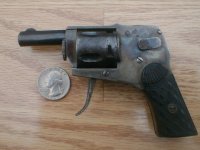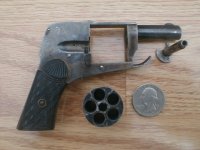I've had this kicking around the house for years. A number of people have looked at it but I still know little about it.
Here's what I suspect ...
Cal. 320 British (.320 Revolver CF). Five round, fluted cylinder, left side of frame safety, vertical screw located in lower frame for possible trigger adjustment. Right side of the barrel & frame displays, "Rampant Lion over PV", "Crown over R" and "Star over M". House of Liege proof on the cylinder. Bore with rifling and cylinder chambers are in excellent condition. Interesting enough the grips appear to be synthetic from a mold, left grip has a small crack. Strong operable action. Three digit serial number on cylinder and frame match.
Any info would be appreciated. If someone has serious interest in this I'm open for trades.
Here's what I suspect ...
Cal. 320 British (.320 Revolver CF). Five round, fluted cylinder, left side of frame safety, vertical screw located in lower frame for possible trigger adjustment. Right side of the barrel & frame displays, "Rampant Lion over PV", "Crown over R" and "Star over M". House of Liege proof on the cylinder. Bore with rifling and cylinder chambers are in excellent condition. Interesting enough the grips appear to be synthetic from a mold, left grip has a small crack. Strong operable action. Three digit serial number on cylinder and frame match.
Any info would be appreciated. If someone has serious interest in this I'm open for trades.


